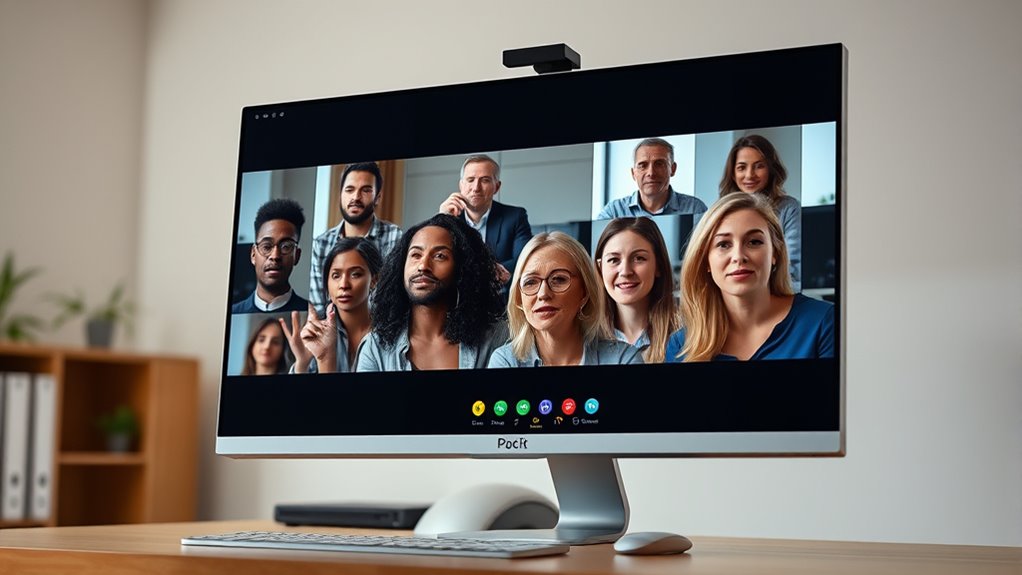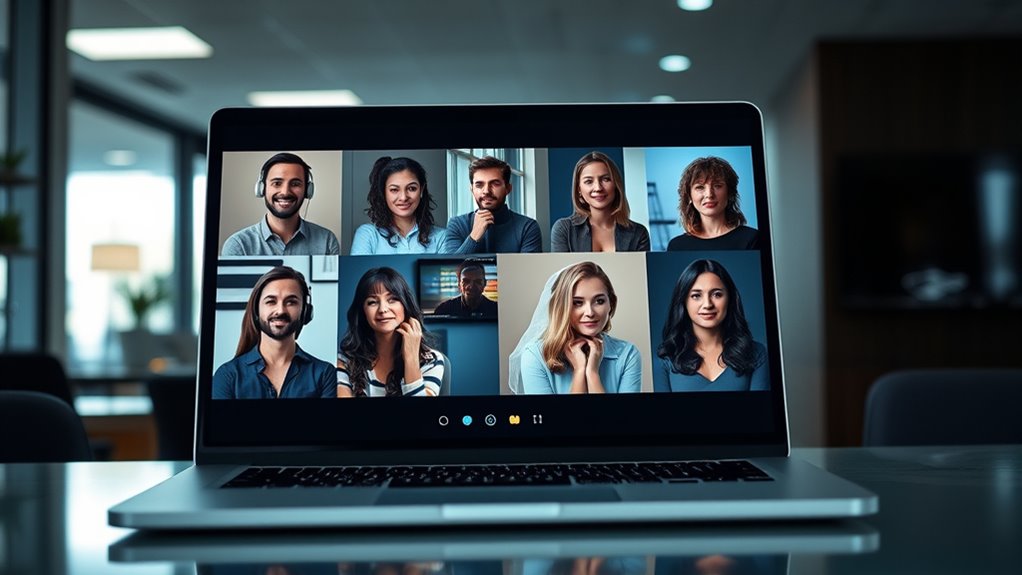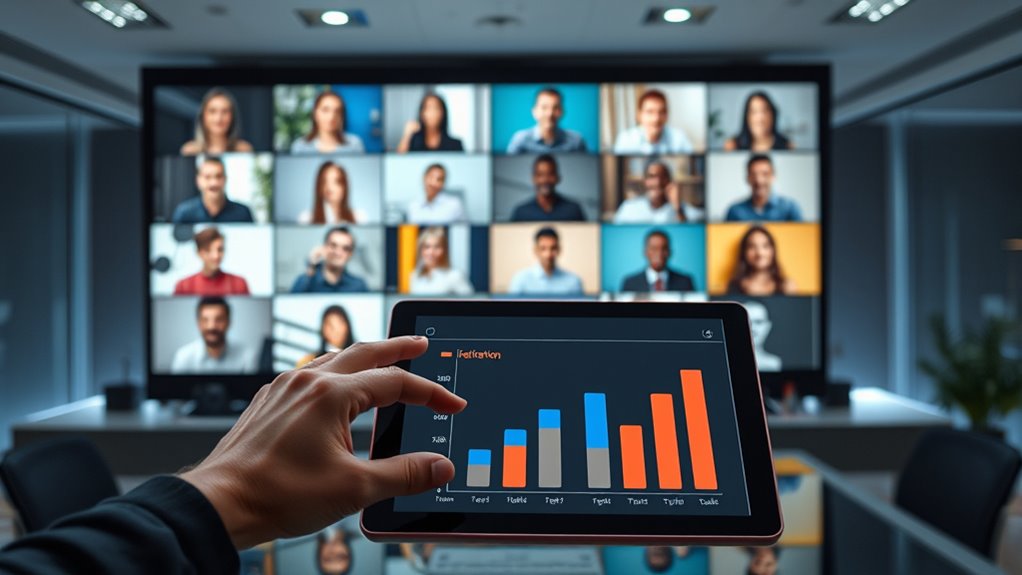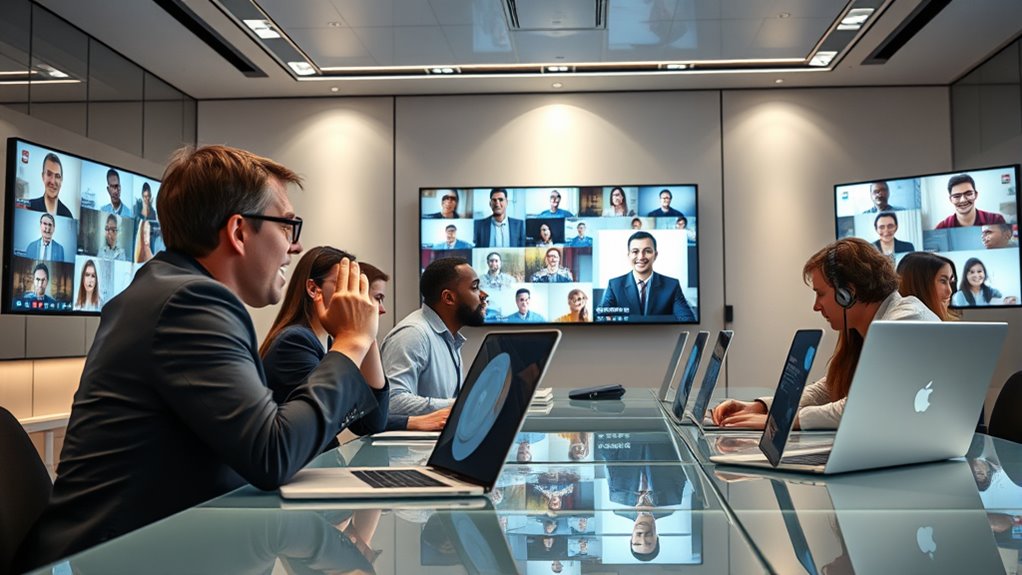In virtual meetings, social facilitation occurs when your behavior and performance are influenced by the presence of others through visible cues, audience presence, and digital interactions. While an engaged audience can boost your motivation and participation, it can also heighten anxiety or distraction. Factors like platform features, social norms, and participant familiarity shape this effect. Understanding these dynamics helps you leverage social cues effectively. If you want to explore how to enhance positive outcomes, there’s more to uncover ahead.
Key Takeaways
- Audience presence in virtual meetings can enhance participation and performance through social facilitation, but may also increase anxiety.
- Visual cues like video visibility and chat activity influence engagement and can trigger social facilitation effects.
- Clear norms, structured agendas, and leadership presence help maximize positive social influences and reduce performance pressure.
- Digital environment factors such as platform features and familiarity among participants modulate the strength of social facilitation.
- Strategies like interactive tools and positive reinforcement foster active participation and optimize social facilitation outcomes.
Understanding Social Facilitation in Digital Contexts

Understanding social facilitation in digital contexts requires recognizing how the presence of others influences your behavior during virtual interactions. In online meetings, nonverbal cues like facial expressions, gestures, and posture become essential for conveying engagement and understanding. These cues help maintain group cohesion, making participants feel connected and motivated to contribute. When others are watching, you often perform better because your effort increases to meet social expectations. This phenomenon is closely related to Cultural Intelligence, as understanding cultural differences can influence how social cues are interpreted and displayed in diverse virtual teams. This effect can boost confidence and productivity, especially when the group feels united. Conversely, the absence of physical presence may weaken some social cues, impacting how effectively you communicate and collaborate. Recognizing these dynamics helps you navigate virtual environments more intentionally, leveraging nonverbal cues to foster stronger group cohesion and improve overall performance.
How Virtual Environments Alter Performance Dynamics

When you’re in a virtual meeting, the presence of an audience can influence how you perform, often amplifying or reducing your confidence. Digital anxiety factors, like fear of judgment or technical issues, can further shape your behavior and output. Additionally, screen visibility effects make it easier or harder to connect, impacting how engaged and effective you are during discussions. Awareness of Gold IRA Rollovers and investment strategies can also influence confidence levels when discussing financial topics in virtual settings.
Audience Presence Impact
Have virtual environments truly changed how audiences influence performance? In online settings, audience presence impacts your behavior differently than in person. When you see a digital crowd, your sense of group cohesion can weaken, making you feel less connected to others. This shift often reduces the pressure to perform at your best, altering social facilitation effects. Leadership influence also plays a role; effective leaders can boost confidence and focus, even through a screen, by fostering trust and engagement. Conversely, a lack of leadership presence may diminish motivation. Virtual audiences tend to be less intimidating, which can lessen anxiety but also decrease accountability. Overall, virtual environments reshape how audience presence impacts your performance, emphasizing the importance of digital cues and leadership in maintaining engagement.
Digital Anxiety Factors
Virtual environments markedly influence how anxiety manifests during performance. When you’re in virtual meetings, digital fatigue can heighten your stress levels, making it harder to focus and perform confidently. Internet dependency adds pressure, as connectivity issues or technical glitches trigger anxiety and disrupt flow. You might feel more self-conscious, knowing every mistake is amplified on screen. This heightened awareness can lead to digital anxiety, impacting your overall effectiveness. Factors like constant notifications or multitasking further drain your mental energy. To manage these digital anxiety factors, it’s vital to set boundaries, guarantee reliable connections, and take regular breaks. Recognizing how digital fatigue and internet dependency influence your performance helps you develop strategies to stay calm and engaged during virtual meetings. Incorporating protective styling benefits can also boost confidence, as well-maintained hair can enhance your professional appearance and reduce self-consciousness.
Screen Visibility Effects
Screen visibility in virtual meetings fundamentally alters how you perform and interact. When your video is on, you’re constantly aware of others’ reactions, which can boost confidence or increase pressure. However, privacy concerns may cause discomfort, making you hesitant to share your surroundings or expressions. Technological barriers, like poor internet connections or camera issues, further impact your ability to engage fully, disrupting the flow and affecting performance. The visibility of your screen also influences social dynamics, as participants may unconsciously modify behavior based on what’s visible. These factors create a different environment from in-person meetings, where body language and proximity play larger roles. Additionally, remote hackathons have shown that virtual settings can foster creativity and expand access to diverse talent, which influences interaction styles. Ultimately, screen visibility shapes your interaction style, balancing engagement with privacy concerns and technological limitations.
The Role of Audience Presence in Online Settings

When your audience is visible during virtual meetings, it can influence how confidently you perform. Virtual presence dynamics often cause engagement levels to fluctuate, affecting your overall effectiveness. Understanding how audience visibility impacts your behavior helps you adapt and stay focused. Additionally, being aware of high-quality projectors can enhance your visual presentation, making it easier to engage your audience.
Audience Visibility Impact
The presence of an audience in online meetings considerably influences participant behavior and performance. When others can see you, your level of audience engagement increases, but so does visibility anxiety. This heightened awareness can push you to perform better or, conversely, cause stress that hampers your focus. The impact depends on your comfort with being visible and your confidence in the virtual environment. Additionally, understanding electric bike capabilities can help in managing expectations related to speed and performance, which may also influence how you perceive your own visibility and competence during online interactions.
Key factors include:
- Increased accountability boosts motivation
- Visibility anxiety may cause nervousness
- Audience presence influences participation levels
- Clear expectations reduce performance pressure
Understanding these effects helps you navigate online settings more effectively. Recognizing how audience visibility impacts your behavior allows you to manage visibility anxiety and leverage audience engagement for better outcomes.
Virtual Presence Dynamics
Audience presence in virtual meetings shapes how participants behave and engage. When you see others on screen, you might feel more compelled to perform confidently, influenced by their virtual presence. Avatar customization allows you to express yourself and project a certain image, impacting how others perceive you and how you behave. Additionally, virtual background effects can influence the atmosphere, making interactions feel more formal or relaxed. These elements contribute to your sense of connection and presence in the online environment, affecting your motivation and comfort level. Understanding these dynamics helps you recognize how audience presence can heighten your awareness and responsiveness, ultimately shaping the social facilitation effect in virtual settings. Your digital choices play a key role in how you participate and engage during virtual meetings. Natural materials and decor choices also influence the overall ambiance, making the environment more inviting and authentic.
Engagement Levels Fluctuate
As your awareness of others’ presence in virtual meetings varies, so does your level of engagement. When you feel connected to the group, your participation tends to increase, reinforcing group cohesion. Conversely, if you’re less aware or disconnected, engagement drops, and peer influence weakens. Your attention shifts based on cues like video visibility and chat activity. This fluctuation impacts group dynamics and collective productivity. Key factors include:
- Visible participants boost accountability and involvement
- Active chat fosters peer influence and shared focus
- Lack of visual cues can diminish engagement
- Strong group cohesion encourages consistent participation
- The Fokos platform emphasizes user interaction and engagement cues to enhance the virtual experience
Understanding these fluctuations helps you recognize how audience presence shapes your responsiveness. By managing these cues, you can enhance your engagement and strengthen the overall virtual meeting experience.
Factors Amplifying or Mitigating the Effect During Virtual Meetings

Several factors can either amplify or mitigate the social facilitation effect in virtual meetings, influencing how visible and evaluated participants feel. Your digital etiquette plays a key role—being respectful and attentive reduces anxiety and fosters virtual team cohesion. Additionally, the meeting platform’s features, like spotlighting speakers or chat functions, can heighten or lessen social pressure. The group’s size matters too: smaller meetings tend to lessen the effect, while larger ones can intensify it. Finally, your awareness of these factors helps you navigate interactions better. Here’s a quick overview:
| Factor | Effect on Social Facilitation | How to Manage |
|---|---|---|
| Platform features | Amplify or reduce visibility | Use spotlighting wisely |
| Group size | Larger increases pressure | Keep meetings focused and smaller when possible |
| Digital etiquette | Builds trust and cohesion | Be respectful and attentive |
| Meeting structure | Clear agendas lessen anxiety | Prepare in advance |
| Participant familiarity | More familiarity reduces effect | Foster team bonding |
| Awareness of content | Helps in managing perceptions | Educate yourself on Glycolic Acid Benefits and applications |
Impact on Task Performance and Participant Engagement

The social facilitation effect in virtual meetings markedly influences both task performance and participant engagement. When group behavior aligns with social norms, you tend to perform better and stay more involved. This effect can boost productivity but might also cause anxiety if expectations feel overwhelming. Recognizing how social norms shape behavior helps you understand these dynamics. Additionally, as AI tools become integrated into virtual environments, understanding these social influences can help optimize AI-enhanced collaboration to support positive interactions.
Strategies to Leverage Social Facilitation for Better Outcomes

To harness the social facilitation effect effectively, focus on creating an environment that encourages active participation and positive social norms. Enhance digital self-awareness by encouraging participants to reflect on how their online presence influences others and their own behavior. Use virtual peer influence strategically by highlighting team successes and fostering a culture of support. Set clear expectations for engagement, such as regular check-ins or prompts, to motivate contributions. Incorporate interactive tools like polls or breakout rooms to stimulate involvement. Recognize and reinforce positive behaviors publicly, which boosts confidence and motivates others. By intentionally shaping the virtual environment, you can leverage social facilitation to improve collaboration, productivity, and overall meeting outcomes.
Recognizing Signs of Social Facilitation in Remote Interactions

Recognizing signs of social facilitation in remote interactions requires attentiveness to how participants behave when they know they are being observed or are part of a group. You might notice increased participation or more confident speaking, driven by social comparison to peers. Look for group conformity, where individuals align their responses or behaviors with others, especially under observation. Participants may also become more engaged during discussions or show heightened emotional expressions when they see others actively contributing. Conversely, some might withdraw if they feel overshadowed or uncomfortable. These signs indicate that social facilitation influences remote behavior, with group dynamics shaping engagement levels. Being aware of these cues helps you understand how virtual environments evoke social facilitation effects, guiding better facilitation strategies.
Future Trends and Research Directions in Virtual Social Psychology

As virtual interactions become increasingly prevalent, researchers are exploring new avenues to understand how social behaviors adapt in digital environments. Future research will likely focus on enhancing virtual team cohesion by identifying strategies that promote effective communication and trust among remote members. Additionally, understanding digital empathy development will be vital for fostering meaningful connections online. You can expect studies to examine how emotional cues are conveyed and interpreted in virtual settings, influencing social facilitation effects. Emerging technologies, like virtual reality and AI-driven feedback, could offer innovative tools to improve social dynamics. Ultimately, these directions aim to optimize remote collaboration, making virtual interactions more engaging, empathetic, and cohesive, ensuring that social psychology principles evolve alongside digital communication platforms.
Frequently Asked Questions
How Do Cultural Differences Influence Social Facilitation in Virtual Meetings?
Cultural differences shape how social facilitation unfolds in virtual meetings. Your cultural norms influence how comfortable you feel participating publicly, while your communication style determines whether you speak up easily or stay reserved. In some cultures, group harmony is prioritized, leading to less overt facilitation, whereas others encourage assertiveness. Understanding these differences helps you navigate virtual settings more effectively, fostering better engagement and collaboration across diverse teams.
Does the Size of a Virtual Audience Affect Participant Performance Differently?
Oh, the grand spectacle of virtual audiences! When the crowd grows, your audience engagement and participant motivation can skyrocket, or plummet into chaos. Larger groups might push you to perform your best, fueled by a desire for approval. Or, they could drown out your voice, making you feel invisible. It’s a gamble—size definitely influences how confident and engaged you feel, shaping your virtual performance in unpredictable ways.
Are There Specific Virtual Tools That Enhance Social Facilitation Effects?
You can enhance social facilitation effects in virtual meetings by using tools with interactive features, like real-time polling, chat sections, and reactions. These features encourage active participation, making attendees feel more engaged and observed, which boosts performance. Incorporating such tools creates a dynamic environment where people are more likely to contribute confidently, leveraging social facilitation to improve overall meeting effectiveness and audience engagement.
How Does Virtual Anonymity Impact Social Facilitation in Online Group Settings?
Your virtual anonymity can totally transform online group dynamics, sometimes making you feel like a superhero or a villain! When your virtual identity is hidden, online disinhibition kicks in, encouraging more open or reckless behavior. This can boost participation and spontaneity, but it might also lead to less accountability. As a result, your true self might shine more or less, depending on how anonymity influences your confidence and interactions.
Can Social Facilitation Lead to Increased Anxiety During Online Presentations?
When you give online presentations, social facilitation can both help and hinder you. It might boost your confidence and improve your performance, but it can also cause increased anxiety and performance anxiety, making you nervous about being judged. If you’re aware of this, you can use techniques to manage your nerves, turning social facilitation into a confidence boost rather than a source of stress.
Conclusion
As you navigate virtual meetings, remember that social facilitation isn’t just a theory—it’s a real force shaping your performance. When others are present online, your motivation and focus can skyrocket or falter, depending on the situation. Embrace this power, and use it to boost your engagement and productivity. By understanding these dynamics, you can turn virtual interactions into opportunities for growth and excellence, proving that connection truly enhances performance—even behind screens.









